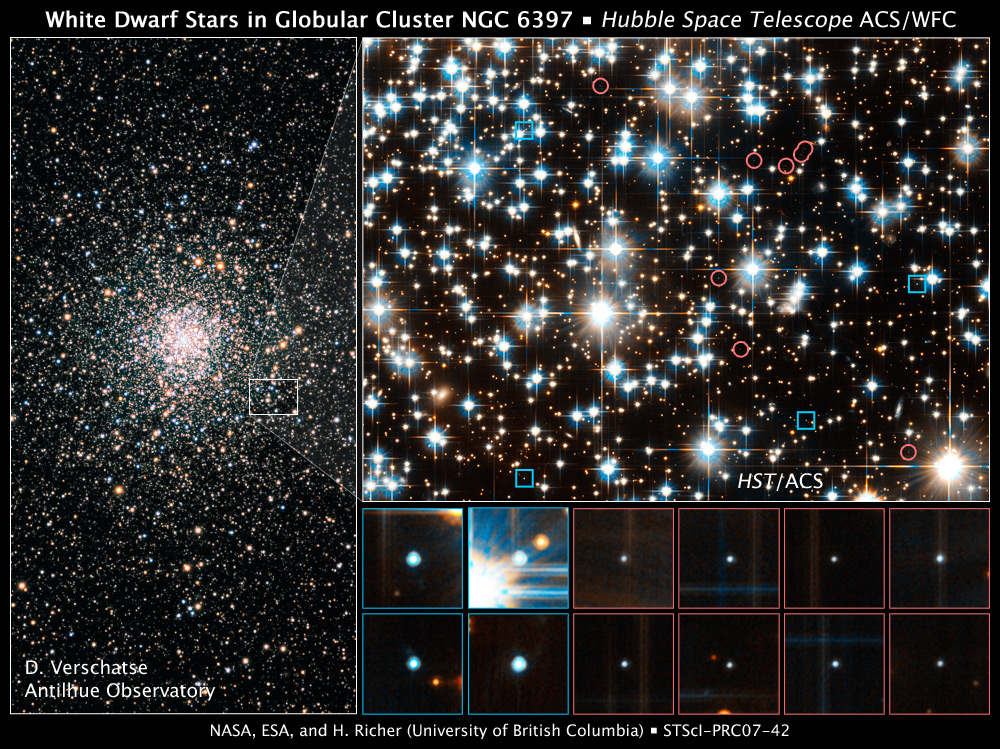University of British Columbia astronomer Harvey Richer and UBC graduate student Saul Davis have discovered that white dwarf stars are born with a natal kick, explaining why these smoldering embers of Sun-like stars are found on the edge rather than at the centre of globular star clusters.
White dwarfs represent the third major stage of a star’s evolution. Like the Sun, each star begins its life with a long stable state where nuclear reactions take place in the core supplying the energy. After the core fuel is depleted, it swells up and turns into a huge red giant. Later, the red giant ejects its outer atmosphere and its core becomes a white dwarf that slowly cools over time and radiates its stored thermal heat into space.

These images show young and old white dwarf stars — the burned-out relics of normal stars — in the ancient globular star cluster NGC 6397. The image at left, taken by a ground-based telescope, shows the dense swarm of hundreds of thousands of stars that make up the globular cluster. The white box outlines the location of the observations made by NASA's Hubble Space Telescope. The image at top, right, taken by Hubble's Advanced Camera for Surveys, reveals young white dwarfs less than 800 million years old and older white dwarfs between 1.4 and 3.5 billion years old. The photo shows 12 of the 84 white dwarfs in the Hubble study. The blue squares pinpoint the young white dwarfs; the red circles outline the older white dwarfs. The Hubble researchers distinguished the younger from the older white dwarfs based on their color and brightness. The younger white dwarfs are hotter and therefore bluer and brighter than the older ones. The astronomers were surprised to find young white dwarfs far away from the cluster's core. They had assumed that the youngsters would reside at the center and migrate over time to the cluster's outskirts. The astronomers proposed that the cluster stars that burn out as white dwarfs are given a boost that propels them to the edge of the cluster. Close-up images of the white dwarfs are shown at bottom, right. The blue boxes represent the young white dwarfs; the red boxes indicate the older white dwarfs. Credit for Ground-based Image: D. Verschatse (Antilhue Observatory, Chile) Credit for Hubble Images: NASA, ESA, and H. Richer (University of British Columbia)
Using NASA’s Hubble telescope, Richer and his team looked at the position of white dwarfs in NGC 6397, one of the globular star clusters closest to Earth. Globular clusters are dense swarms of hundreds of thousands of stars. About 150 of these clusters exist in the Milky Way, each containing between 100,000 and one million stars.
“The distribution of young white dwarfs is the exact opposite of what we expected,” says Prof. Richer, whose study will appear in the Monthly Notices of the Royal Astronomical Society Letters in January 2008.
Richer explains that globular clusters sort out stars according to their mass, governed by a gravitational billiard-ball game among stars. Heavier stars slow down and sink to the cluster’s core, while lighter stars pick up speed and move across the cluster to its outskirts. The team found that the older white dwarfs were behaving as expected; they were scattered throughout the cluster according to weight.
“Newly-minted white dwarfs should be near the center, but they are not,” says Richer. “Our idea is that when these white dwarfs were born, they were given a small kick of 7,000 to 11,000 miles an hour (three to five kilometers a second), which rocketed them to the outer reaches of the cluster.”
Using computer simulations, Richer and his team showed that when white dwarfs were born, their own mass acts like “rocket fuel” propelling them forward.
“If more of this mass is ejected in one direction, it could propel the emerging white dwarf through space, just as exhaust from a rocket engine thrusts it from the launch pad,” says Richer.
The researchers studied 22 young white dwarfs up to about 800 million years old and 62 older white dwarfs between 1.4 and 3.5 billion years old. They distinguished the younger from the older white dwarfs based on their color and brightness. The younger ones are hotter, and therefore bluer and brighter than the older ones.
Study co-authors are: I. King, University of Washington; J.Anderson, Space Telescope Science Institute; J. Coffey, UBC, G. Fahlman, National Research Council of Canada's Herzberg Institute of Astrophysics; J Hurley. Swinburne, University of Technology; and J. Kalirai, University of California, Santa Cruz.




Comments